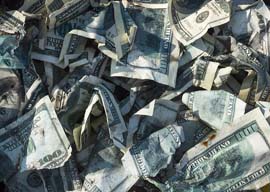
March 03, 2016

Source: Bigstock
Insider commentators like ZeroHedge‘s Tyler Durden resist mainstream economists” call for eliminating large-denomination bills in part because they see the move as the beginning of a transformation toward a cashless society”which is another story. Durden and his co-writers believe the true motivation for killing big notes is to remove a significant amount of cash from the economy. “Bills and coins account for about 10% of M2 monetary aggregates (currency plus very liquid bank deposits) in the US and the Eurozone. Presumably the goal of this policy is to bring this percentage down to zero.” In Europe, approximately one-third of all euro cash is held in the form of “¬500 notes. “By forcing people and companies to convert their paper money into bank deposits, the hope is that they can be persuaded (coerced?) to spend that money rather than save it because those deposits will carry considerable costs (negative interest rates and/or fees). This in turn could boost consumption, GDP and inflation to pay for the massive debts we have accumulated,” ZeroHedge suggests. Another reason behind the call may be to empower central banks and to avoid a run on bank withdrawal. It seems like a desperate ploy either way. What convenience do we trade in the next time we (inevitably) encounter economic stagnation?
Drug money floats the global economy and, according to Ivanov, it represents “The Overlooked 6% of World Trade.” He argued in 2011 that the degree of impact of oil and gas on the world economy is common knowledge: They account for about 6% of total global trade. Yet “the impact of the narco market, which is estimated at approximately the same size, is not looked at by economists and politicians.” Why not? Ivanov argues that the current financial system can no longer exist without injections of dirty money. “Periods of crisis merely aggravate and expose the liquidity problem, making it more evident.”
Ivanov warns of “this possibility of permanently supplying much needed liquidity, that is in many ways the driver of the financial, economic, and social demand for continuing narcotics production.” Liquid narco money fertilizes the present economic system, he says. Estimates including those by U.N. experts indicate “the narco-money in the world is on the order of $800 billion per year…. And this allows us to confidently assert that narco-money is the foundation of the modern financial system.”
The cashless society is coming, yet much narco capital is held in cash. This poses fascinating questions, like how money laundering takes place in a digital economy, and whether we can sustain a purely licit economy, in practice not in theory. Equally worrying, and not unlikely, is the chance that cartels switch cash (or merchandise) for gold, diamonds, or any legal commodities that liberate them from the currency trap, thereby distorting the value of those commodities and their markets. The game will change and the players will adapt.
The point is that, for all the advantages a cashless economy might confer upon society, it is not certain that digital currencies will successfully lock out the proceeds of illicit trade. If successful, however, the cost of isolating narco wealth creation may be unaffordable, compared with the beneficial impact of narco liquidity on today’s global economy, especially in times of crisis. Locking narco capital out of the banking system might be good for the price of gold in the long term. Whatever happens, though, the narcos” net economic power”if diverted”may create a greater, not lesser, threat to our society, its institutions, and their corruptibility. Worst-case scenario, where current economic dangers materialize simultaneously, without the steady stream of narco liquidity the bottom could fall out of the global economy.